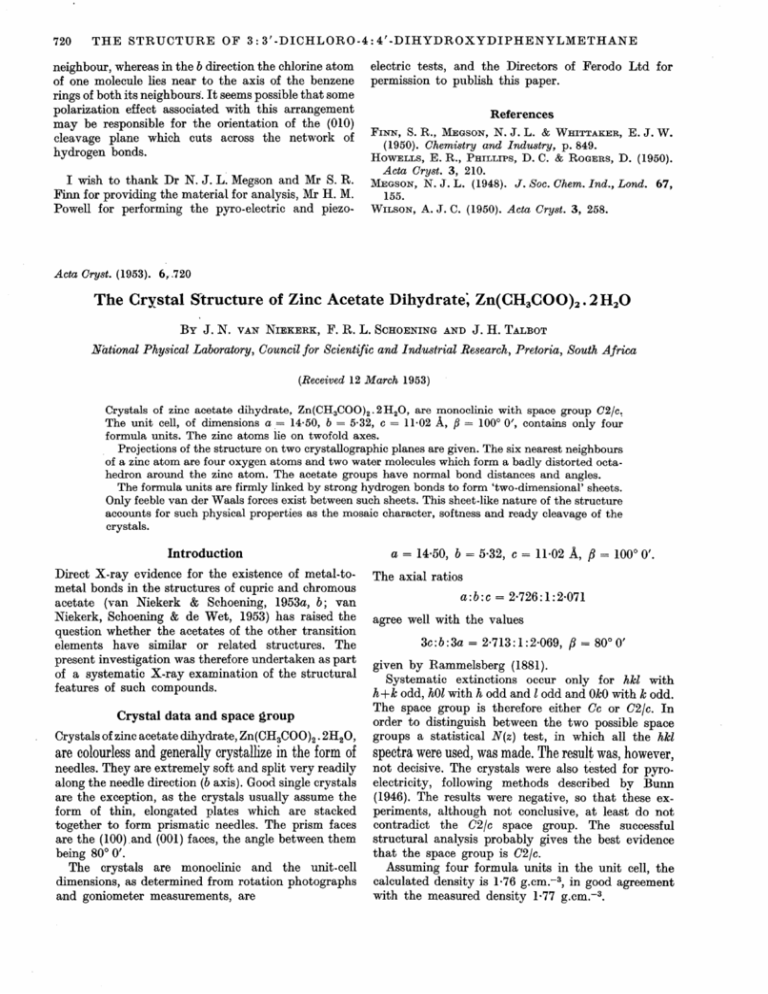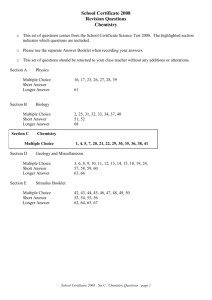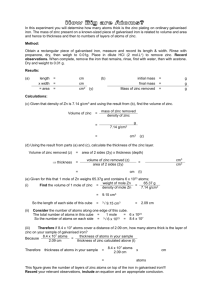The crystal structure of zinc acetate dihydrate, Zn(CH3COO)2.2H2O
advertisement

720
THE
STRUCTURE
OF 3:3'-DICHLORO-4:4'-DIHYDROXYDIPHENYLMETHANE
neighbour, whereas in the b direction the chlorine atom
of one molecule lies near to the axis of the benzene
rings of both its neighbours. I t seems possible t h a t some
polarization effect associated with this a r r a n g e m e n t
m a y be responsible for the orientation of the (010)
cleavage plane which cuts across the network of
hydrogen bonds.
I wish to t h a n k Dr N. J. LI Megson and Mr S. R.
F i n n for providing the material for analysis, Mr H. M.
Powell for performing the pyro-electric and piezo-
electric tests, and the Directors of Ferodo L t d for
permission to publish this paper.
References
FINN, S.R., MEGSON, N. J. L. & WHITTAKER, E. J. W.
(1950). Chemistry and Industry, p. 849.
HOWELLS, E. R., PHILLIPS, D.C. & ROGERS, D. (1950).
Acta Cryst. 3, 210.
MEGSON, N. J. L. (1948). J. Soc. Chem. Ind., Lond. 67,
155.
WILSON, A. J. C. (1950). Acta Cryst. 3, 258.
Acta Cryst. (1953). 6,..720
T h e Crystal Structure of Zinc Acetate Dihydrate~ Zn(CH3COO)2.2 H20
:BY J . N . vA~ ~IEKERK, F. 1:~. L. SCHOENING AND J. tI. TALBOT
Ni~tional Physical Laboratory, Council for Scientific and Industrial Rezearch, Pretoria, South A.frica
(Received 12 March 1953)
Crystals of zinc acetate dihydrate, Zn(CHaCOO)~.2H20, are monoclinic with space group C2/c.
The unit cell, of dimensions a = 14.50, b ---- 5.32, c ---- 11.02 /~, fl ---- 100 ° 0', contains only four
formula units. The zinc atoms lie on twofold axes.
Projections of the structure on two crystallographic planes are given. The six nearest neighbours
o f a zinc atom are four oxygen atoms and two water molecules which form a badly distorted octahedron around the zinc atom. The acetate groups have normal bond distances and angles.
The formula units are firmly linked by strong hydrogen bonds to form 'two-dimensional' sheets.
Only feeble van der Waals forces exist between such sheets. This sheet-like nature of the structure
accounts for such physical properties as the mosaic character, softness and ready cleavage of the
crystals.
Introduction
Direct X - r a y evidence for the existence of metal-tom e t a l bonds in the structures of cupric and chromous
acetate (van Niekerk & Schoening, 1953a, b; v a n
Niekerk, Schoening & de Wet, 1953) has raised the
question whether the acetates of the other transition
elements have similar or related structures. The
present investigation was therefore u n d e r t a k e n as part
of a systematic X - r a y e x a m i n a t i o n of the structural
features of such compounds.
Crystal data and space group
Crystals of zinc acetate dihydrate, Zn(CHaC00)2.2H~O,
a -- 14.50, b = 5-32, c = 11.02/~, fl = 100 ° 0'.
The axial ratios
a:b:c = 2.726:1:2.071
agree well with the values
3c:b:3a = 2.713:1:2.069, fl = 80 ° 0'
given b y R a m m e l s b e r g (1881).
Systematic extinctions occur only for hkl with
h + k odd, hO1 with h odd and 1 odd and 0k0 with/c odd.
The space group is therefore either Cc or C2/c. I n
order to distinguish between the two possible space
groups a statistical N(z) test, in which all the hkl
are c010urless and generally crystallize in the form of
spectra were used, was made. The result was, however,
needles. T h e y are extremely soft and split very readily
along the needle direction (b axis). Good single crystals
are the exception, as the crystals usually assume the
form of thin, elongated plates which are stacked
together to form prismatic needles. The prism faces
are the ( 1 0 0 ) a n d (001) faces, the angle between t h e m
being 80 ° 0'.
The crystals are monoclinie and the unit-cell
dimensions, as determined from rotation photographs
and goniometer measurements, are
not decisive. Tile crystals were also tested for pyroelectricity, following methods described b y B u n n
(1946). The results were negative, so t h a t these experiments, although not conclusive, at least do not
contradict the C2/c space group. The successful
structural analysis p r o b a b l y gives the best evidence
t h a t the space group is C2/c.
Assuming four formula units in the unit cell, t h e
calculated density is 1.76 g.cm. -a, in good agreement
with the measured density 1.77 g.cm. -a.
J. N. VAN N I E K E R K ,
F. R. L. S C H O E N I N G AND J. H. T A L B O T
Preliminary estimate of the structure
Since the general point position in the C2/c space
group is eightfold, and since there are only four
formula units in the unit cell, it follows that the zinc
atoms must occupy special positions. These positions
are symmetry centres and twofold axes. Should the
zinc atoms occupy symmetry centres, the hkl intensities
should conform approximately to certain extinction
conditions. As these conditions were not convincingly
obeyed, it seemed reasonable to infer that the zinc
atoms lie on twofold axes. This point was tested by
evaluating the P(0, v, ½c) section. For this purpose
equi-inclination Weissenberg photographs, using Cu Kc~
radiation, were taken of the first four layers for a
crystal rotating about the b axis, and the above Harker
section was evaluated (Fig. 1). It is evident from this
721
The final a(y, z) projection is shown in Fig. 3.
The notation is the same as for Fig. 2, crosses agMn
indicating the positions of atoms belonging to the
same formula unit. The two heavy dots on the projection indicate the positions of a carbon atom and of a
water molecule which are derived by symmetry from
corresponding atoms indicated 5y crosses.
c >
+~
10
~"
o
02
o~
/
_ ,,-;.~;,cy/~ ->
/H20°(~ ~~
K)
/~¢~
+ ~
0
0
T
1,b
Zn
Fig. 1. H a y k e r section P ( 0 , v, ½c). The final zinc position
is indicated.
diagram that the zinc atom lies at a distance ~b from
the glide plane, thus ruling out the possibility of the
zinc atoms occupying symmetry centres as these lie
either on or midway (at a distance ¼b) between the
c-glide planes. Using as origin t h a t given in International Tables for the C2/c space group, the position
of the zinc atom was taken at (0, ~b, to).
Fig. 2. E l e c t r o n d e n s i t y p r o j e c t e d along b on to t h e a c plane.
C o n t o u r s are d r a w n a t 2 e./~ -9 intervals, t h e o u t e r line is
t h e t w o - e l e c t r o n level. The h e a v y c o n t o u r is t h e 40-electron
level. Crosses indicate t h e final a t o m i c positions. A t o m s
assigned w i t h small circle suffixes are r e l a t e d to corres p o n d i n g l y m a r k e d ones b y t h e t w o f o l d axis on which lies
t h e zinc a t o m .
~H~O~ /~H~O
o~ v>\ ~ /
Projections of the structure on two crystallographic planes
For evaluating the a(x, z) and a(y, z) projections, the
intensities of the spectra recorded on multiple-film
zero-layer Weissenberg photographs were estimated
visually and corrected for Lorentz and polarization
factors. Cu K~ radiation was used and in view of the
small size of the crystals no corrections were made for
absorption and extinction effects. Using Lipson &
Beevers' strips, the a(x, z) projection was evaluated
first. The signs of the relevant F(hO1) terms were
calculated from the zinc co-ordinates only, terms of
doubtful sign being omitted during the preliminary
projections. Successive refinements, using all the recorded spectra, finally gave the projection shown in
Fig. 2. In this diagram the atoms are well resolved
and the crosses indicate the atomic positions finally
chosen. Atoms assigned with small circle suffixes are
related to correspondingly marked ones by the twofold axis.
AC6
1
2
3
4A
l L1 i I i I J I
0
1
I ~ 11
2
3
4A
f J I J I
Fig. 3. Electron density projected on the bc plane. Contours
and labelling .of atoms are as for Fig. 2. The inner contour
of the two double peaks is the fourteen-electron level.
The two heavy dots represent atoms related by symmetry
to corresponding ones marked by crosses. Atoms marked
by crosses all belong to the same formula unit.
The co-ordinates given in Table 1 were estimated
from the two projections.
With these co-ordinates, structure factors were
Table 1. Final parameters
Atom
Zn
01
02
H~O
C1
C2
x
0.000
0.071
0.103
0.088
0.113
0.183
y
0.125
0.200
0.423
-- 0.150
0.400
0.527
z
0.250
0.095
0.267
0"354
0.145
0.083
46
722 T H E
CRYSTAL
STRUCTURE
OF
ZINC
ACETATE
DIHYDRATE,
Zn(CHaCOO)2.2H20
T a b l e 2. Observed and calculated structure factors
hkl
200
400
600
800
10,0,0
12,0,0
Fo
185
31
8
46
77
48
.Fc
4 174
--11
4 6
+50
4 96
460
14,0,0
15
15
415
4 19
9
6
65
< 7
130
21
92
77
49
35
< 4
152
13
58
87
24
16
4 15
+6
-- 62
0
-- 150
W33
-- 103
+ 72
--41
+31
0
-- 157
~420
--50
4 67
-- 19
4 7
16,0,0
18,0,0
020
O40
060
0O2
004
006
008
0,0,10
0,0,12
0,0,14
202
204
206
208
2,0,10
2,0,12
205
203
206
208
2,0,10
2,0,1_22
2,0,14
402
404
406
408
4,0,10
4,0,12
405
403
406
40~
4,0,1-0
4,0,1-2
89
- - 90
147
110
52
69
40
10
27
68
58
37
6
< 7
93
144
68
13
25
26
+ 134
--94
+ 46
+53
433
-- 10
--43
+ 70
--49
431
--11
+ 4
-- 70
+ 132
-- 69
+20
--23
+28
hk l
4,0,14
602
604
606
608
6,0,10
6,0,12
602
603
60g
60~
6,0,10
6,0,1-~
802
804
806
808
8,0,10
8,0,12
802
803
806
80g
8,0,10
8,0,12
10,0,2
10,0,4
10,0,6
10,0,8
10,0,10
10,0,210,0,4
lO,O,g
10,0,_~8
2'0
17
47
73
57
38
13
10
43
129
50
<
10,0,10
10,0,12
12,0,2
12,0,4
12,0,6
12,0,8
12,0,~
12,0,3
12,0,6
8
0
12
20
97
78
22
28
31
< 5
73
79
28
48
37
9
70
53
15
< 6
27
66
18
39
82
28
6
24
18
18
< 7
28
15
35
calculated using the iollowing temperature corrections"
for the carbon atoms the f values obtained by Roberts o n (1935) w e r e u s e d , w h i l e f o r t h e o x y g e n a t o m s p r o portionately reduced f values were used; for the zinc
i o n t h e f0 v a l u e s g i v e n b y J a m e s & B r i n d l e y (1931)
for the neutral zinc atom were modified in the same
w a y as t h e i r f0 v a l u e s f o r n e u t r a l c o p p e r h a v e t o b e
modified to give their calculated copper ion values.
To these modified zinc values an isotropic temperature
factor with B - 3.2 was then applied.
The observed and calculated structure factors are
t a b u l a t e d i n T a b l e 2. T h e a g r e e m e n t is g o o d a n d ,
n e g l e c t i n g a b s e n t s p e c t r a , R f a c t o r s of 0.15 a n d 0.16
w e r e o b t a i n e d f o r t h e hOl a n d 0kl s p e c t r a r e s p e c t i v e l y .
The interatomic distances and angles given in Table
3 were calculated from the co-ordinates tabulated in
T a b l e 1.
Considering the agreement between the observed
and calculated structure factors, together with the
sound interatomic distances that were obtained, there
hkl
12,0,.._g
12,0,1__00
12,0,12
14,0,2
14,0,4
14,0,6
14,0,2
14,0,3
14,0,~
14,0,8
14,0,10
16,0,2
16,0,3
-~c
--20
-- 66
44-73
--56
441
--12
4 10
-- 39
4111
- - 52
--17
426
-- 102
+ 81
--25
4 33
--33
4 10
-- 80
+ 73
--26
445
--37
+ 2
--62
460
--23
4 9
--26
-- 86
421
--55
+ 74
--29
+ 5
--29
417
--23
+ 9
--42
430
--45
16,0,6
021
022
023
024
025
026
027
028
029
0,2,10
0,2,11
0,2,12
0,2,13
041
042
043
044
045
046
047
048
049
0,4,10
061
062
063
064
065
.Fo
30
13
12
10
9
12
23
20
13
< 8
8
17
16
15
19
28
47
19
78
< 8
50
< 8
< 8
< 7
< 7
< 6
20
33
61
14
30
6
16
11
30
9
29
< 7
< 7
27
< 6
21
le c
4}-36
--21
44-17
-- 5
411
--17
--32
4{-29
-- 16
4 9
--ll
--19
416
- - 15
--33
--20
+52
-{-20
--89
-- 8
+51
+ 1
-- 5
-- 4
411
44- 2
--20
417
44-62
4 6
--35
+11
+ 16
--11
--32
+ 1
428
+ 9
+ 7
--30
-- 8
418
T a b l e 3. Interatomic distances and angles
(All distances are in AngstrSm units and all angles
in degrees)
Zn-0 z
Zn-02
Zn-H20
O1-C x
O2-C z
Cz-C 2
O1-O2
2.18
2.17
2-14
1"30
1.38
1-48
2.21
Ol-C1-O 2
111
0z-Zn-O u
Ol-Zn-H20
Ol_Zn_Oz o
Oz-Zn-O2 °
O2-Zn-tt20
02-Zn-02 °
H20-Zn-H20 °
H20-Zn-Oz °
H20-Zn-O2 °
61
103
158
104
96
85
94
92
152
s e e m s l i t t l e r e a s o n t o d o u b t t h e v a l i d i t y of t h e s p a c e
.group a n d of t h e s t r u c t u r e . T h e c o r r e c t n e s s of t h e
s t r u c t u r e is f u r t h e r s u b s t a n t i a t e d
b y a P ( u , 0, w)
p r o j e c t i o n (Fig. 4), f o r w h i c h o n l y o b s e r v e d d a t a w e r e
utilized. On this projection the final atomic positions,
as d e r i v e d f r o m t h e t w o F o u r i e r p r o j e c t i o n s , a r e
i n d i c a t e d b y crosses a n d i t is c l e a r t h a t t h e . P a t t e r s o n
J. N. V A N
NIEKERK,
F. R. L. S C I I O E N I N G
vectors to the peak maxima coincide almost exactly
with these crosses. The interpretation of the Patterson
c
0
ii
Fig. 4. Patterson projection P(u, 0, w). Contours are drawn
at arbitrary levels. Crosses indicate the final atomic positions
obtained from the two electron density projections. The
five Patterson peaks are numbered.
vectors is obvious when this diagram is compared
with Fig. 2.
Description of the m o l e c u l e
The structure is best described by referring to Fig. 2.
The six nearest neighbours of a zinc ion are four oxygen
atoms at distances 2.17 and 2-18 /l~ and two water
molecules at distances 2.14 /~. These six bonds are
probably mainly ionic in character. The six atoms
form a greatly distorted octahedron around the zinc
ion. The degree of distortion is probably accounted for
by the 01-0~ distance (2.21 _~) of the acetate group
which is much too short to allow for the formation
of a regular octahedron. The two acetate groups are
separately planar, the angle between their planes
being 85 °. The 01-C 1 distance (1.30/~) is shorter than
the 09-C1 distance (1.38 /~). However, as C1 is not
clearly resolved in either of the two Fourier projections, this difference may not be very reliable. The
C1-C~ distance is 1.48 _~.
AND
J. H . T A L B O T
parallel to the b axis. Along such columns the units
comprising them are firmly linked by hydrogen bonds
of length 2.49 J~. Referring to Fig. 2, such bonds exist
between the two water molecules (H20 and H20 °) of
one unit which are bonded respectively to the two
oxygen atoms (02 and 02 °) of the unit immediately
above.
Adjacent columns of formula units are also linked
in the c direction in the following manner. The two
water molecules (H~O and H90 °) belonging to a unit
in one reference column are bonded respectively to
the two oxygen atoms 01 and 01 ° of two units belonging to the two columns which are adjacent to the
reference column. These are again hydrogen bonds of
length 2.74/~.
From the above discussion it is clear that hydrogen
bonds firmly link the units in the structure in such a
manner as to form effectively 'two-dimensional' sheets
parallel to the bc plane. Considering the bonds between
such sheets, i.e. in the a direction, it is found that the
separation between adjacent sheets is much too large
to allow for any but comparatively weak van der Waals
forces between them. This sheet-like nature of the zinc
acetate structure accounts for its stacked plate-like
crystal habit, the softness and the marked cleavage
of the crystals.
In conclusion we wish to thank Mr H. Schumann
of the National Chemical Research Laboratory for
preparing the crystals and the Council for Scientific
and Industrial Research for permission to publish
this paper.
References
BuNN, C.W. (1946). Chemical Crystallography, p. 289.
Oxford: Clarendon Press.
JAMES, R. W . & BRINDLEY, G. ~V. (1931). Z. Krystallogr.
78, 470.
NIEKERK, J . N . VAN & SC•OENING, F . R . L .
Discussion of the bonding
The arrangement of formula units in the structure is
such that along the c direction each unit lies at a
height ~b above or below the one preceding it, while
in the a direction adjacent units differ in height by
~b. Along the b direction the units are separated by
the b spacing (5.32 /~) and form extended columns
723
Nature, Lond. 171, 36.
NIEKERK, J . N . VAN & SCHOENING, F . R . L .
Acta Cryst. 6, 227.
(1953a).
(1953b).
NIEKERK, J . N. VAN, SCHOENING, F. R. L. & WET, J . F .
DE, (1953). Acta Cryst. 6, 501.
RAMMELSBERG, C.F. (1881). Handbuch der kristallographisch-physi/calischen Chemie. Leipzig: Engelmann.
ROBERTSON, J.M. (1935). Proc. Roy. Soc. A. 150, 106.









